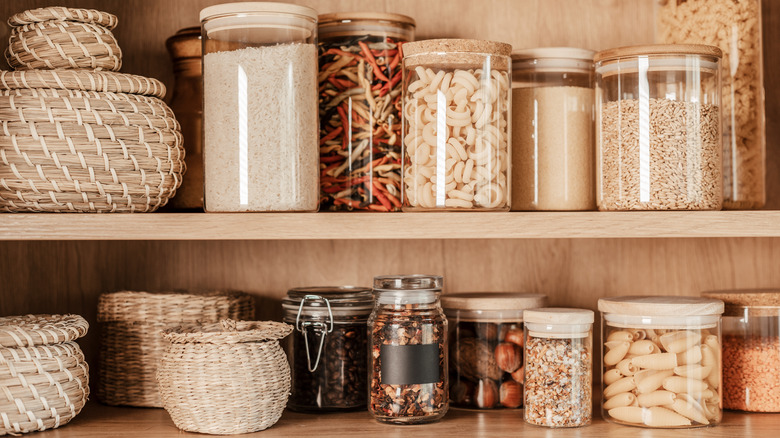Should You Decant Pantry And Baking Staples? A Storage Expert Weighs In
If you've spent any time in the domestic blogosphere or on Organization TikTok, you've likely encountered the term "decanting" and might be curious about its meaning. While decanting is most commonly associated with wine — pouring it from its original bottle into a new vessel slowly enough to leave any sediment behind — the term can also mean simply "to pour out," such as transferring a product from its original grocery store packaging to a reusable container.
In pantry organization, decanting refers to moving dry goods from their original packaging to clear, labeled containers. When you see influencers with perfectly organized cabinets full of minimalist, uniform containers, they're practicing decanting. Apart from making you look like the patron saint of domesticity, decanting baking supplies and other pantry items has practical benefits. It helps maintain freshness, and enables you to easily see how much of an ingredient remains. Still, if you haven't started decanting, you might wonder whether it's worthwhile.
Before investing in a mountain of new containers and opening all your dry goods, consider a few factors to determine if decanting is right for your household. We spoke with Maria Baer, founder of The Baer Minimalist, an organization service in Indianapolis, who offered some tips to consider when deciding to decant.
The benefits of decanting
Maria Baer told Daily Meal that she personally likes "to get rid of as much cardboard as possible," mainly because clear storage containers allow you to see exactly how much of an item you have every time you open the cabinet, unlike opaque boxes and bags. Moreover, many people find that matching containers create a nicer and less visually cluttered appearance than a variety of mismatched branded packaging.
"I'm sure we've all been in a situation where we thought we had a large quantity of a particular item only to find the box completely empty when we needed it," Baer explained. Therefore, decanting proves useful not just for ready-to-eat items like your favorite breakfast cereal and pretzels, but also for baking ingredients like flour and sugar, helping to avoid ingredient shortages mid-recipe.
Decanting also aids in maintaining freshness and protecting food from pantry moths, since sturdy glass or plastic containers are less penetrable than most commercial packaging. It's simpler to maintain an airtight seal with a container than by folding a bag and securing it with a clip. If you're not planning to consume a whole bag of store-bought tortilla chips or pretzels at once, decanting can keep them fresher longer. Additionally, since some packaging is flimsy (we're looking at you, flour bags), decanting can prevent rips and spills.
Decanting is not for everyone
Despite the allure of a matchy-matchy pantry, decanting every dry item isn't practical for all households.
"So often I find that people like the look of decanting, but struggle with upkeep," Maria Baer cautioned. "It takes time to decant items when you get home from the grocery store, and all of the sudden you have half filled canisters of food AND more of the same type of food stored in a basket elsewhere."
Baer engages in "real talk" with her clients to assess if and how decanting suits their needs. For individuals who cook in small quantities, decanting can be beneficial for storing goods that might otherwise remain in poorly resealed packaging. However, for those who use entire packages of food at once (like a whole box of pasta), decanting becomes an unnecessary step. It might be practical to decant certain items but not others — perhaps keeping cereal in its box, but placing individually packaged snacks in a basket for easy access.
If you decide to decant groceries, labeling is crucial to avoid confusion — nobody wants to mix up their salt and their sugar. Baer also suggests her clients note the expiration date on the bottom of their containers. If the packaging includes important information, like cooking times, she advises cutting out that section and attaching it to the container for quick reference.


